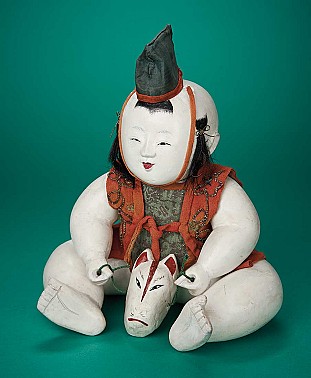Outstanding Carved Wooden Courtesan (Oiran) and Her Procession, Mid-1800s
Lot #47
15" (38 cm.) courtesan, 12" attendants, 13 1/2" male chaperones. Each has carved wooden head, hands and lower legs, and is mounted on pebbled wooden base, The courtesan with glass eyes, refined nose, green accent on lips, teeth, silk fiber hair in elaborate upswept fashion ornamented with tortoise-shell decorations (two in the shape of a fan), and wearing superb costume comprising purple silk outer kimono (uchigake) with embroidered crane and wave designs, inner red kimono with embroidered wisteria pattern, and with six interior kimono collars with embroidery, six kimono hem borders whose padding was designed to allow a more sensuous presentation when strolling, and platform sandals (geta). Her elaborate obi, tied in front to indicate her role and status, is richly embroidered, including gold threads, with design of a dragon amidst swirling clouds (the dragon with glass inset eyes). Her lady attendants are apprentice courtesans (kamuro) and have painted facial features including accented green lips, silk floss hair with different coiffure and hair ornaments and are wearing rare matching costumes of red silk crepe (chirimen) with cherry blossom design, fawn-spotted silk obi, and platform sandals (geta). Also included are two male chaperones with unusual highly-distinctive features, each with different expression, glass inset eyes, bald pate with stylized black silk fiber hair inset at the sides and as topknot, thickly-padded silk plaid or striped kimono with unusual red, white and blue streamers on the side of obi, bare feet, one with umbrella, and one holding a staff. Excellent condition. Late Edo period, circa 1860. The artistry and luxury quality of this Courtesan Procession indicates her status as a high ranking courtesan (Oiran-Gyoretsu), The five-person set is remarkable to find complete and has exceptional details of characterization, textiles, accessories, presence, and fine state of preservation.


















































































































































































































































